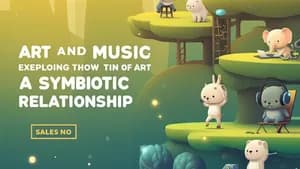Introduction: Seeing the Sound
Music, an intangible art form, exists only as vibrations in the air, yet it evokes powerful emotions and vivid imagery in our minds. How can we capture these fleeting sensations, these ephemeral feelings, in a permanent visual form? That's the challenge artists have taken on for centuries, and it's a fascinating journey to explore. This article will delve into the ways artists have visually represented music, examining how they transform abstract musical concepts into concrete visual expressions. We'll look at different approaches, historical examples, and practical exercises you can try to better understand this compelling intersection of art forms.
Depicting Musical Form and Structure
One of the most direct ways artists have visualized music is by representing its structure. Think of the classical composers' scores—those meticulously organized pages filled with notes, rests, and symbols. These scores themselves are a visual representation of the music's architecture. Artists have taken inspiration from this, often creating visual pieces that mirror the musical structure, such as using geometric shapes to represent themes or variations. Imagine a painting where a series of concentric circles represents the building crescendo of a symphony, the size of the circle directly correlating to the volume of the music. You can explore this further by taking a piece of music – maybe your favorite song – and sketching out its structure. Try using different colors and shapes to represent different sections, tempo changes, and dynamics. This hands-on approach will help solidify your understanding of musical form.
Representing Musical Emotion and Mood
Beyond structure, music evokes emotions. A somber melody might make you feel melancholy, while an upbeat rhythm can fill you with joy. Artists translate these feelings through color, texture, and composition. Think of the rich, dark colors often used to depict the tragic aspects of an opera. The chaotic brushstrokes might mirror the turbulent emotions expressed within the music. Conversely, a bright, vibrant palette can portray the exhilaration of a lively dance. For a practical exercise, choose a piece of music that evokes a strong emotion in you. Then, create a visual representation focusing on the color palette and texture to capture that feeling. You might use soft pastels for a peaceful piece or bold impasto techniques for something dramatic. Pay attention to the details; the texture can communicate the texture of the music's emotion.
Symbolizing Musical Ideas and Concepts
Sometimes, artists go beyond literal representation and use symbolism to capture the essence of music. Abstract art, for instance, excels in this. Think about the way Kandinsky's paintings seem to vibrate with color and form, mirroring the vibrancy and complexity of music. He believed in

